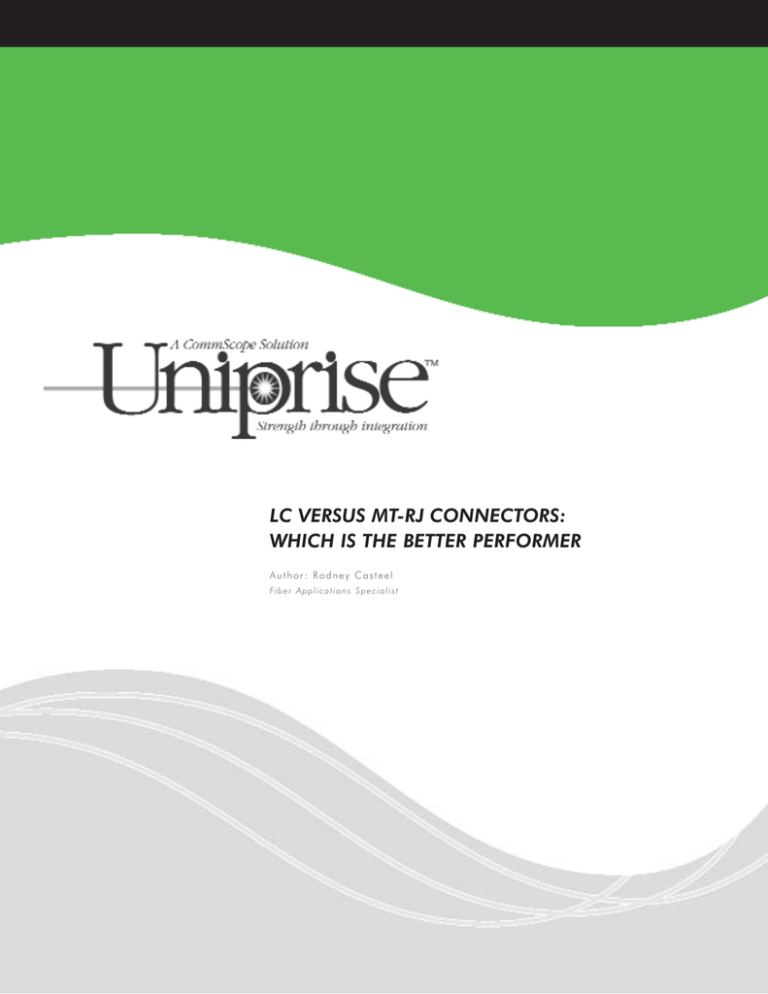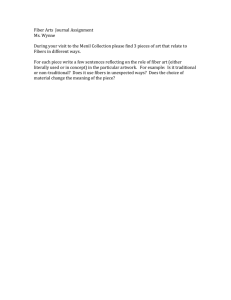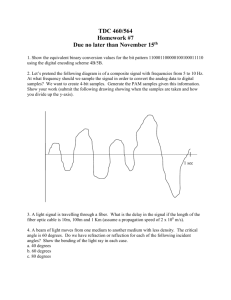
LC VERSUS MT-RJ CONNECTORS:
WHICH IS THE BETTER PERFORMER
A u t h o r : Ro d n e y C a s t e e l
Fi b e r A p p l i c a t i o n s S p e c i a l i s t
When fiber optic connectors were first developed, performance was the key design issue. But now that fiber is the first choice
for telco networks and a growing presence in private data LAN/WANs, another issue has gained prominence - connector size.
Shelf space in central offices and telecommunications rooms is becoming scarce through the use of bulky ST and SC connectors.
SFF (Small Form Factor) connectors were developed to put more fiber connections into the same space. They also took
advantage of advances in design and materials to deliver levels of performance beyond that of those first-generation connectors.
Two styles of SFF connector have found favor in the marketplace - the highly-promoted MT-RJ and the workmanlike LC. Both
address the need for high density and low insertion loss. But despite the hype, there are solid reasons that the LC is the preferred connector for high-performance networks.
History
The MT-RJ is a variation on the MT ribbon fiber
connector developed by Nippon Telephone and
Telegraph. In its original design, the MT could hold
as many as 12 fibers. The connector manufacturer
AMP adapted the MT design to hold only two fibers
in an inexpensive rectangular plastic ferrule. The
MT-RJ was aggressively marketed upon its introduction as THE small form factor connector. MT-RJ
design was later standardized in EIA/TIA-604-12
and is now offered by several other manufacturers.
The LC connector was developed by Lucent
Technologies as a response to the need by their primary customers, the telcos, for a small, low insertion loss connector. The LC is a single fiber connector that borrows a cylindrical ferrule (usually ceramic) and split-sleeve construction from its predecessor,
the larger SC connector. Two LCs can be easily
yoked together into a duplex assembly that occupies
the same area as a single SC (some manufacturers
offer a true duplex LC). The primary customers were
the public telcos who have specified Lucent (formerly BellCore) components for decades. The LC
design was standardized in EIA/TIA-604-10 and is
offered by several other manufacturers.
How The Connectors Connect
The version of the MT-RJ connector used to terminate cable is male, with two steel alignment pins
that fit into the female receptacle. The connector is
locked into place with an RJ45-style clip. Fiber is
cleaved and placed in the ferrule where it is
mechanically held in place.
An LC connector terminates in an adapter and
meets a similar connector face-to-face. The connectors are held in the adapter with an RJ45-style clip.
The fiber is inserted into a ceramic ferrule that is
then polished. An interesting feature of the LC is
that the ferrule can be 'tuned' or rotated with a special tool after it has been assembled. This offers a
considerable performance advantage as will be
shown below.
How Design Effects Performance
The MT-RJ is a complex mechanism. Proper function
requires that four items be precisely positioned; the
two alignment pins (and their holes) and the two
fibers. Assuming 3μm manufacturing tolerance for
the pin/hole positioning/diameters and a 2μm tolerance for the fiber placement reveals a worst-case
scenario of as much as 5 μm of offset.
But is that truly worst-case? Remember that the MTRJ has a plastic body and it is difficult to maintain a
2μm tolerance in plastic molding. There is a chance
that the offset could be much greater. And when
fiber concentricity is figured into the equation, the
offset could be enough to cause a significant power
loss. By attempting to consistantly align two fibers at
once, the MT-RJ opens itself up to some potential
problems.
The beauty of the LC connector is due to an inherently simple design; everything revolves around a
single axis - a single fiber core. When clicked into
the adapter, the ferrule (with the fiber positioned to
within 1.4μm of its center) is placed inside a receiving bore that aligns it with another connector.
Assuming a manufacturing tolerance of 3μm for the
bore, there is very little opportunity for 'wiggle.' Even
in a worst-case scenario, the maximum offset would
be 4.4μm in the core-to-core interface at the
adapter.
The difference is easily shown in the measured performance of the multimode versions of the connectors; average insertion loss from a factory installed
MT-RJ is 0.3dB, but for an LC is 0.2dB.
For single-mode connectors, the tolerances must be
even tighter because of the narrow fiber core. The
LCs ceramic ferrule allows tolerances of down to
1.4μm. While the tolerance for the diameter of the
metal pins in the MT-RJ can be tightened, the features molded into the plastic ferrule cannot. Using
materials such as semiconductor-grade silicon for
the ferrule have been tried, but that drives up the
cost considerably. The average measured single-
mode performance for a factory installed tuned LC
is 0.08dB and average return loss of greater than 55dB, while the MT-RJ has an average factory insertion loss of .4dB with a typical reflection of -40dB.
How Installation Effects Performance
The MT-RJ is positioned as a craft-friendly connector, a claim that is based on the fact that no polishing is required. Fiber is stripped, cleaved and
placed so that it is flush with the pre-terminated
fiber in the tip of the ferrule.
However, a problem arises during the cleaving
stage; it takes a good bit of practice and a good
cleaving tool to achieve a clean flat cleave of less
than 1° of perpendicular. If the cleave is angled
more than that, it can create an air space that could
cause crippling attenuation and reflection loss.
The flat face of the MT-RJ accentuates this air space
reflection loss. The fiber must be installed so that it
is absolutely flush with the front of the connector.
Installing the MT-RJ incorrectly will open up a gap
that will cause reflection loss. These factors are easily seen in the average reflection loss figures for the
connector types; a typical single-mode LC has only
-55dB of loss (and an even lower -75dB if angled)
while the typical single-mode MT-RJ only achieves a
-40dB of reflection loss performance.
A third problem is the mechanism that holds the
fiber in place. The clamp that holds the fiber may
introduce stress that results in additional loss
through micro bending. It should be noted that the
clamp does not provide as much tensile strength
and fiber support as the ferrule of the LC.
A fourth problem caused by the 'two-fibers-at-once'
philosophy of the MT-RJ is fiber polarity; an installer
may accidentally reverse the position of the tx and rx
fibers. Fortunately, some MT-RJ connectors are reenterable and the problem is fixable, but not without
some effort. This two-fibers-at-a-time approach creates another inherent problem. With a two fiber
connector, if only one fiber gets damaged, two
fibers still have to be reterminated. However, with
the LC, if one fiber gets damaged only one fiber has
to be reterminated. This means less labor and
material cost.
Even the best of craftsmen run into problems such
as fiber that has an eccentric core. However, the LC
addresses this post-installation with its 'tune-ability.'
Using a special wrench, an LC connector can have
the ferrule rotated in 60° increments that helps align
core mismatches.
Testing
While the concept of "two fibers" at a time sounds
good in theory, it poses yet another problem in the
field, which is testing. According to the TIA/EIA568-B.3 standard, the recommended test method is
a one jumper reference. However, the current hand
held test sets are not capable of testing a two fiber
connector utilizing a one jumper reference.
To test a two fiber connector with current hand held
test sets, two composite jumpers are needed and a
minimum of a two jumper reference (and in some
cases a three jumper reference). A two and three
jumper reference test may not reflect the actual loss
of the system as accurately as a one jumper reference.
Incontrast, the LC connector having only one fiber
per ferrule is much simpler to test. Many of the
hand held test sets today are available with the LC
interface and can take advantage of a one jumper
reference, which will better simulate the actual performance of the fiber network.
Conclusion
Sometimes simple is better. The classic one-fiber-ata-time approach of the LC connector coupled with
its tunability makes it the right choice for the lowloss, high performance SFF connector of the present
and the future. For these reasons many of the electronic manufacturers are standardizing on the LC as
the connector interface of choice for higher speed
networks. While the MT-RJ was popular for a while
with some electronic manufacturers for their low
speed 10/100 systems, they have discovered that
the complexities, expense and poor performance of
the MT-RJ make it an unfavorable connector for
their higher speed electronics; therefore they are
switching to the more simplified and cost effective
LC connector.
AB
®
1100 CommScope Place SE Hickory, NC 28603
P: 800.544.1948 828.459.5000 F: 828.459.5099
www.uniprisesolutions.com
©2005 CommScope Inc. All Rights Reserved. All trademarks identified by ® or ™
are registered trademarks or trademarks, respectively, of CommScope.
10/05




